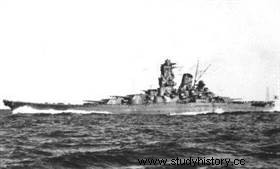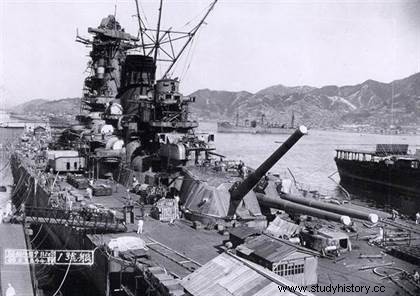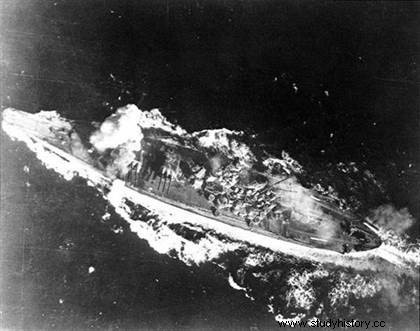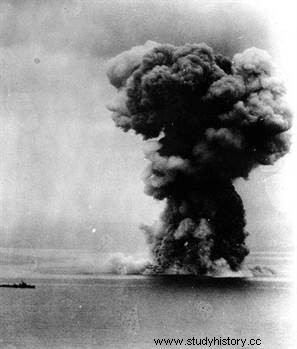 Measuring 263 meters in length and weighing over 65,000 tons, the battleship Yamato , star of the Imperial Japanese Navy, was the largest battleship ever built. The Second World War could have been the peak of these giants, it was their cemetery. This was the case for the famous Yamato, sunk in April 1945. Very quickly supplanted by aircraft carriers, these monsters of the seas, heirs to the great sailing warships of the Navy's Golden Age, saw their most illustrious representatives experience contrasting destinies. After the heroic Graf Spee raids and Bismarck , the agony of the Prince of Wales and Repulse or the miraculous escapes of Jean Bart and Scharnhorst , what happened to the biggest of them all, the Yamato ?
Measuring 263 meters in length and weighing over 65,000 tons, the battleship Yamato , star of the Imperial Japanese Navy, was the largest battleship ever built. The Second World War could have been the peak of these giants, it was their cemetery. This was the case for the famous Yamato, sunk in April 1945. Very quickly supplanted by aircraft carriers, these monsters of the seas, heirs to the great sailing warships of the Navy's Golden Age, saw their most illustrious representatives experience contrasting destinies. After the heroic Graf Spee raids and Bismarck , the agony of the Prince of Wales and Repulse or the miraculous escapes of Jean Bart and Scharnhorst , what happened to the biggest of them all, the Yamato ?
The battleship Yamato , a giant... that floats!
How could such a monster ever set sail? Let us rather judge:a displacement of 64,200 t; a length of 263 meters; a width of 39 meters; a 400 mm main armor belt; an armament composed, among other things, of three turrets, each with three 457 mm caliber guns, capable of firing shells weighing more than one ton; all of which can spin at 27 knots (i.e. more than 50 km/h)! Able to carry more than 3,000 men, the Yamato was the most powerful battleship of the war, even beyond the Bismarck or the last American battleships (type Iowa for example).
 Developed from 1934, before the cancellation of the limitation standards affecting warships, its keel was started on November 4, 1937 in Kure; it entered service on December 16, 1941, nine days after the attack on Pearl Harbor. Initially intended to be the flagship of a "super-fleet", it was transformed throughout the war into a simple flagship, while its twin brother, the Musashi , was sunk in the Gulf of Leyte at the end of 1944 by the American air force (it still took nineteen torpedoes and seventeen bombs to overcome it), almost without having fought; a third example, the Shinano , was quickly converted into an aircraft carrier, a symbol in itself of the loss of power of the battleships during this war.
Developed from 1934, before the cancellation of the limitation standards affecting warships, its keel was started on November 4, 1937 in Kure; it entered service on December 16, 1941, nine days after the attack on Pearl Harbor. Initially intended to be the flagship of a "super-fleet", it was transformed throughout the war into a simple flagship, while its twin brother, the Musashi , was sunk in the Gulf of Leyte at the end of 1944 by the American air force (it still took nineteen torpedoes and seventeen bombs to overcome it), almost without having fought; a third example, the Shinano , was quickly converted into an aircraft carrier, a symbol in itself of the loss of power of the battleships during this war.
A long time away from the fire
Entered service after Pearl Harbor, the Yamato stays away from fighting for a long time, actively in any case. He was in almost all the battles following December 7, 1941, in particular Midway in 1942 and the Battle of Leyte Gulf in 1944, where he was also briefly bombarded. Yet at no time did the Yamato cannot bring his terrible main artillery into action, simply because he has no opponent! From May 1942, most of the decisive battles were played out without the fleets meeting face to face, it was only up to the embarked aviation to act; this is obviously the case at the Coral Sea and the Battle of Midway, but also later in the Eastern Solomons. There are certainly some "real" naval battles, with guns, during the battle of Guadalcanal for example, but they are on a small scale and relate more to cruisers.
 When the Japanese believe they can finally use the fantastic firepower of the Yamato , fate decides otherwise; thus, at Midway again, Admiral Yamamoto wants to throw his ships of the line, including the Yamato , in battle for a night fight. But the victorious American fleet, which had already sunk four Japanese aircraft carriers, cautiously withdrew.
When the Japanese believe they can finally use the fantastic firepower of the Yamato , fate decides otherwise; thus, at Midway again, Admiral Yamamoto wants to throw his ships of the line, including the Yamato , in battle for a night fight. But the victorious American fleet, which had already sunk four Japanese aircraft carriers, cautiously withdrew.
In Leyte, while the Yamato is integrated with her sister ship the Musashi at Admiral Kurita's battle squadron, tasked with attacking the American invasion fleet, the plan fails when it comes to taking the enemy by surprise; it was the latter who took the initiative with his air force, bombarding the Japanese fleet and therefore sinking the Musashi . Kurita's hesitations finally prevent his squadron and the Yamato to be decisive when, at last, they manage to make contact with the enemy fleet and fire. The Japanese admiral decides to withdraw, for fear of sacrificing for nothing the last large unit of the Imperial Navy, which can still be useful in the defense of Japan.
The Yamato sacrificed in Okinawa (April 1945)
The other major American operations which see the conquest of Japanese strongholds do not allow the Japanese general staff, which has almost no aircraft carriers left, to risk his last naval forces. He will do so only when the homeland is threatened.
This is what happens when the Americans decide to attack the island of Okinawa. The battle to defend it must be the great last stand of the Imperial Navy (and the army), with the aim of inflicting maximum losses on the enemy to force him to give up a landing in Japan.
Yet once again the Yamato does not seem to be a priority in Japanese plans. Previous battles (and defeats) have confirmed the need for mastery of the sky, and it is on this aspect that Japanese efforts are made for Okinawa. But they have barely two thousand aircraft, and especially crews whose training has not been completed... Among them, as in Leyte, many candidates for suicide attacks.
The Battle of Okinawa begins, and we wonder what role the Yamato will be able to play . On April 4, the battleship was integrated into a mobile force intended to counterattack, and above all to serve as a bait for the fleet of American ships to lure it into the Japanese land-based aviation sector. Very quickly, we understand that the attack of the Yamato , called “special”, will in fact be suicide; with his escort the Yahagi he only receives the one way ration of his fuel…
The small Yamato squadron finally sets sail on April 6, 1945, and she is quickly spotted by the enemy aviation. However, it is first submarines that threaten her, pushed aside by the destroyers of the escort. The night passed, relatively peacefully, and on the morning of April 7 the battleship continued on its way south, apparently without being spotted by the Americans. It was only around noon that the squadron received a message mentioning the takeoff of more than two hundred planes from American aircraft carriers, for a major attack on Okinawa! Enemy aircraft soon appear in clusters; it is first and foremost the rear guard of the Yamato squadron who is hit, then his very heart, all with persistently bad weather that handicaps defenders even more than attackers.
 Anti-aircraft artillery of Yamato was greatly improved from the beginning of 1944, thanks to the use of the "San-shiki" projectile (taken from the main parts), capable of creating a cone of fire of 400 meters by 1000 meters, over a range of 30 kilometers! But without air protection, this is not enough in the face of a massive attack by enemy planes, especially when they are protected by a cover of low clouds...which prevents the firing of large guns, and therefore "San-shiki"! It is not 1 p.m., and the Yamato already hit by two bombs, then by a torpedo; at the same time, the cruiser Yahagi is badly hit and must stop, and a destroyer is sunk.
Anti-aircraft artillery of Yamato was greatly improved from the beginning of 1944, thanks to the use of the "San-shiki" projectile (taken from the main parts), capable of creating a cone of fire of 400 meters by 1000 meters, over a range of 30 kilometers! But without air protection, this is not enough in the face of a massive attack by enemy planes, especially when they are protected by a cover of low clouds...which prevents the firing of large guns, and therefore "San-shiki"! It is not 1 p.m., and the Yamato already hit by two bombs, then by a torpedo; at the same time, the cruiser Yahagi is badly hit and must stop, and a destroyer is sunk.
A short lull, and new American waves appear about twenty minutes later. A second destroyer is hit, then the Yamato himself, who this time received two torpedoes. Another escort is then sunk in turn.
The Agony of Battleship Yamato
A third raid does not let the Japanese breathe:they are nearly one hundred and fifty aircraft to swoop down on the Japanese squadron, determined to put an end to it, including twenty torpedo boats just for the Yamato ! The battleship was hit three times, seriously since one of the rudders was destroyed and its starboard compartments were flooded... Its speed and maneuverability were therefore seriously impaired. Meanwhile, the Yahagi yielded under the blows and sank in turn.
At 2 p.m., the Yamato was then hit right in the middle by three bombs, then a few minutes later three torpedoes hit her again, two to port, one to starboard. The big ship is gradually lying on its side and only advancing at seven knots. However, it was a quarter of an hour later that the fatal torpedo hit it:the Yamato bends down, the ammunition rolls into the holds and ends up exploding, and the battleship with it. He takes more than 3000 men into the abyss, only 269 will be saved...
The Sacrifice of Yamato and his squadron was ultimately of little use:the Imperial Navy is no more, and the island of Okinawa falls after some of the worst fighting of the war. The road to Japan is open. As for the adventure of the battleships, it is definitely over. In 2005, the Yamato Museum was opened in the city of Kure, which houses a 1/10th reproduction of the famous battleship.
To go further
- Jean Moulin's World War II battleships. 2009.
- Bernard Ireland's 20th century battleships. 2004.
